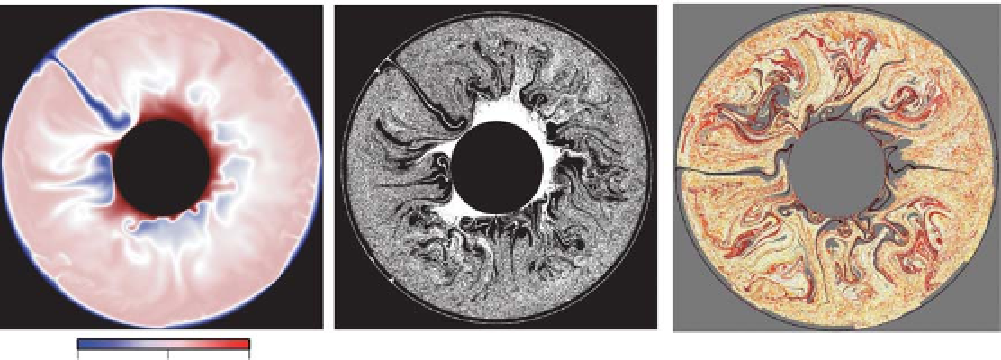Geoscience Reference
In-Depth Information
atmosphere, suggesting 50% is still retained. This
does not necessarily require a separate unde-
gassed reservoir. Rather, it indicates that mantle
degassing is incomplete since not all mantle ma-
terial has been processed by melting at the mid-
oceanic ridges (van Keken & Ballentine, 1998;
1999; Ellam & Stuart, 2004; Albar ede, 2005; Bran-
denburg
et al
., 2008).
An illustration of the use of these simple, global
geophysical and geochemical constraints is pro-
vided by Brandenburg
et al
. (2008). Figure 12.4
shows a snapshot of temperature, composition
and time since the tracer was last melted in a mid-
oceanic ridge. The higher viscosity in the lower
mantle makes the remixing sluggish and het-
erogeneity between oceanic crust (identified by
white tracers) and depleted mantle (or harzburgite
in the upper mantle, identified by black regions)
remains strong, even though the effects of folding
and entrainment are clearly visible. The lower vis-
cosity of the uppermost mantle, combined with
the high plate velocities, sets up very efficient
shearing and mixing of the heterogeneities, creat-
ing an upper mantle that is significantly better
mixed than the lower mantle. We follow the
isotopic evolution in the U-Th-Pb, Sm-Nd, Rb-Sr
and Re-Os systems (Figure 12.5). Over time, the
segregration and remixing of the oceanic crust,
and the continental crust extraction at subduc-
tion zones leads to mixing arrays that cover the
isotopic end-members of DMM, HIMU and EM1
fairly well. A critical assumption is that we need
to assume a change from ''dry'' subduction in a
hotter Earth to ''wet'' subduction in a cooler Earth
(McCulloch & Gamble, 1991). As was noticed by
other workers (e.g., Rudge, 2006) this transition
needs to be assumed around 2-2.5 Ga. This likely
represents the aforementioned switch from plate
tectonics in a hotter Earth to more modern plate
tectonics. In our isotopic models we find that
EM-I is associated with older (
>
2 Ga) subducted
oceanic crust, whereas HIMU is associated with
more recently subducted crust, which is in agree-
ment with suggestions from earlier work (Hart
et al
., 1986; Elliott
et al
., 2007).
We can further test this type of geodynam-
ical model by comparison with seismological
observations. As an example, Deschamps and
Tackley (2008, 2009) compared the spectra of
their 3D Cartesian thermochemical models with
(b)
(c)
273
1500
T (K)
3273
(a)
Fig. 12.4
Thermochemical mixing models similar to those in Brandenburg
et al
. (2008) with temperature (left),
MORB fraction (middle; MORB particles are white) and age since last melting in the MORB particles
(right: black/red is young, yellow/white is old). The core size is reduced in these cylindrical models to better
represent the relative surface area of the Earth's core (van Keken, 2001). Reproduced with permission of Elsevier.
(See Color Plate 13).

